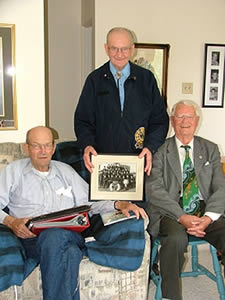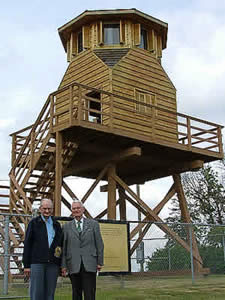- — On This Page —
- • Sharing Memories
- • After 60 Years
- • Related Pages
Remembering Camp 135
We Meet Again
Sharing Memories

Allan Fleming, Gordon Wright
and Hansgeorg Mertsch
Erika Foley photo
Like it was yesterday…
Memories from 61 years ago came flooding back as Allan Fleming of Wainwright met with Gordon Wright of Edmonton and Hansgeorg Mertsch of Germany Sunday, June 12, at his home.
On April 14,1944, Fleming and Wright were aboard the frigate HMCS Swansea which shelled and sunk the German submarine U-448 that Mertsch was in. The two Canadians also rescued that day, many of the German submariners from the cold waters of the Bay of Biscay.
Fleming read in the Saturday, June 11th Edmonton Journal about Wright and Mertsch coming to Wainwright for a tour of WATC, and wanted to meet them.
Fleming had many photos of the day they shelled the U-448, as well as a large picture of the Swansea crew, which shows him standing behind Wright. “Isn’t that interesting. We were on the same ship together when we came back from overseas, landing in Halifax,” Wright commented.
The two men reminisced about days spent on board the ship. They talked about the depth charges and how they could tell how deep they went. They talked about other crew members. Fleming hasn’t been in touch with any, but now he has a contact to many of them through Wright. They both recalled one man who had trouble docking the ship properly and hit the jetty. “He was lucky to get that close,” Fleming laughed, and Wright agreed.
“I was on the quarter deck, pulling them (German U-boat survivors) up from the scrambling nets,” Wright said. Fleming was pulling them directly from the water.
They also spoke about Towney, the ships’s mascot, who had a litter of pups on the ship.
Over coffee, as Hansgeorg joined them, they shared more stories and pictures. The three men went back in time talking about the war years when they were young and fighting for their country. They survived, and on this day they spoke together about the war years, something they don’t do very often.
Accompanying the two men from the city were Wright’s wife Isabel, and their daughter Kathy and son Ken. As the women chatted with Allan’s wife, Fern, she commented, “The only time they’ll talk about it is when guys get together. They never speak about it when just women are around.”
These three mariners will keep in touch now, because they have something in common—memories of a day 61 years ago when their lives became entangled through the events of WWII.
Text & photos: Erika Foley
Posted: June, 2005.
Editor’s note: Since the time of this posting Mr. Fleming passed away; he was laid to rest in November, 2005.
• Top• After 60 Years •
Returning to Camp Wainwright 60 Years Later

Gordon Wright amd Hansgeorg Mertsch
Beyond Recognition
As Hansgeorg Mertsch toured WATC Sunday, June 12, he looked for signs of what once was his residence for 18 months.
Georg was a German POW here, brought here January 30, 1945; left June, 1946. A sub-lieutenant on U-boat, U-448, his submarine was bombed by the frigate HMCS Swansea on April 14, 1944. Most of the subs crew was rescued by the Swansea or the HMS Pelican. (Allan Fleming was on the Swansea - story in Monday’s Star).
On the Swansea was Gordon Wright. Gordon travelled to Germany in 1996 for a U-488 reunion. There he met Georg. Now Georg was in Canada where Gordon was taking him to see the sites of the camps he had been held in during the war - Wainwright and Seebe (five months).
Georg talked about dusts storms, saying that dust storms on the prairies were something the prisoners didn’t think of.
At the POW tower, as Captain Kevin Winfield showed him around, Georg commented, “There’s nothing yet I remember so far.”
As he travelled to the oldest part of the camp, where the two remaining former POW barracks are located, he commented, “This hits you like a hammer in the head.”
Once inside he commented that it had changed beyond recognition. “You put in a wall, the whole thing looks different.”
He remembered that the doors were at the ends of the building, not in the middle like it is now. The showers and bathrooms (wet section) were in the hallway where the present entryway is.
He also remembered a wild cat that came into the building. They fed it milk from a saucer and she had three kittens inside the place. “A big dog went in one day, and the cat was very ferocious and jumped on the dog, scratching his nose. The dog ran away and never came back,” he said.
Memories came back of making wine from berries with a makeshift still located in the bathroom areas outside between the barracks. A Canadian guard found the site one day before the wine was ready, and they talked him into waiting one day before he dismantled it. “Both sides were satisfied,” he commented. “We had Operation Musk Ox - a really big party.”
Memories of getting outside the camp at night behind the large spot lights. Guards in the tower could not see into the dark behind the huge lights.
He saw the buffalo and toured the military police building. There he was presented a famed picture of the POW tower, and a camp history book, as well as pins to take home. Gordon was also presented with a history book.
“We didn’t have T.V. nor much radio. The main source of information was the print media. I subscribed to the Edmonton Bulletin when I was here and every morning I had a a newspaper. Since then I’ve made it a habit to buy a local newspaper where ever I go,” he said. He took a copy of the latest Edge with him.
He learned English in Wainwright and Seebe, and learned much about the history of Canada and the CP and CNR.
After a quick visit to the museum and a light lunch at the Galleria, Hansgeorg, Gordon, his wife Isabel, and their son and daughter Kathy and Ken, left Wainwright.
“Time goes on. It’s more densely populated now. It’s not the same as when I was here in ’45.”
Text & photos: Erika Foley
Related Pages
- Related:
- Camp 135
- | The Enemy Within
- | Leo Hamson
- | We Meet Again
- | Homefront
- • Top •
- The Camp Wainwright Story
- | Home
Photos courtesy of Erika Foley
© 2005 -2010- • Reviewed on 2010-08-15
- • from my ten fingers to the web